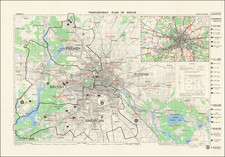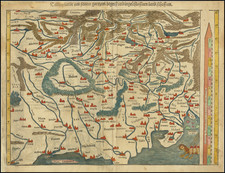A Nazi Propaganda Poster by "One of the Masters of Suggestive Cartography" - G. Henrik Herb
This is a Nazi propaganda map, suggesting, in no uncertain terms, German territorial ambition. The map itself depicts the diaspora of ethnic Germans throughout Europe in extensive, if exaggerated, detail. Quotes from around the map and annotations describe the nature, extent, and supposed oppression faced by these ethnic Germans.
Shades of red on the map indicate German settlement. The map indicates the German population of each area, with Germany having close to 76 million ethnic Germans within its borders. Romania has eight million, Hungary six million, the Soviet Union 1.1 million, and Sweden only six thousand ethnic Germans. Other symbols are used to indicate certain areas, such as those that have people with a Germanic "cultural potential," such as the "Alpenromanen" people in Italy and Switzerland. Two insets show Germanic settlements in the "Volgarepublik" and "Kaukasus" regions.
The arrows drawn across the map are foreboding given the coming Generalplan Ost, but these refer to supposed Germanic migrations during the Middle Ages. It appears that this is taken as an example of Germans already needing Lebensraum as early as the Middle Ages.
The message of this map is perhaps best summarized by the quote included in the upper left of the map, which is from Hitler's address to the Reichstag on February 20, 1938:
"In the long run, it is unbearable for a world power to know that there are Volksgenossen [compatriots] at its side being constantly subjected to the most severe suffering because of their sympathy or affiliation with their race, its fate, and its world view!"
In this excerpt, Hitler is attacking the fact that ethnic Germans are being "oppressed" in other countries, and the speech drives home the supposed need to liberate these people of Germanic descent.
The map mentions an article from Der Schulungsbrief [The Training Letter]'s January 1938 issue. This magazine aimed to portray Nazi ideology in an understandable manner for the public. The magazine was published from at least 1934 until April 1944 (and perhaps later), featuring such articles as "The War Criminal Churchill" and "Victories of Racial Strength." The magazine shifted its focus of publication in line with the trajectory of Nazi propaganda, first focusing on racial issues, then on Germans abroad, then on the successes of the war effort.
Arnold Hillen-Ziegfeld was a leading cartographer in Nazi Germany. He had been active since at least 1925, publishing numerous works of propaganda. His early work focused on Jewish peoples, being published in Volk unter Volkern, and then shifted to addressing the issue of the German population abroad. This transition from "domestic" to "international" issues closely mirrors the focus of Nazi propaganda on the whole. Assisting Hillen-Ziegfeld were two professors, including Dr. Dr. (as he preferred to be known, having two doctoral degrees) Friedrich Lange, another leading figure of Nazi cartography. The data was provided by Lange's research and excludes German-speaking Jewish people.
The Volksdeutsche in Europe
The notion of Pan-Germanic romantic nationalism had influenced German policy since at least the 19th century. The most obvious early impact of this ideology was the unification of Germany in 1871. Pan-Germanism also influenced ethnically German thinkers and politicians throughout Europe, particularly in Austria. This is not to say that a sense of German nationalism did not exist prior to unification, with a prominent example of Germanic pride being the German name for Transylvania in the 17th century, naming it "Sibenburgen," referring to the seven ethnically German cities of the region.
Pan-Germanism is rooted in the historical migrations of Germanic tribes. The spread of Germanic peoples throughout Europe occurred extensively during the Middle Ages, during and after the fall of Rome. The Germanic peoples, a general name for various tribes which included the Visigoths, Burgundians, and Ostrogoths, arrived in western Europe while fleeing the advancing Huns. These tribes settled in many different places throughout Europe, ranging from Spain to Russia.
In Nazi ideology unifying the Volksdeutsche in a Greater Germanic Reich became a matter of primary importance. They saw these communities as being oppressed in a foreign land by inferior majorities. This ideology is one of the most important tenets for understanding the foreign policy of the Nazi government.
Alongside the need for Lebensraum, the existence of the Volksdeutsche was leveraged to garner public support for expansion. Supposed (and occasionally real) oppression against Germans in Poland, Czechoslovakia, the Baltic nations, and elsewhere were used as reasons for expansion. This propaganda campaign was successful in both persuading the German people that war was necessary, and in exciting German nationalism elsewhere in Europe, particularly in the Sudetenland.













![(Second World War - Eastern Front) [The Soviet Encirclement of Konigsberg]](https://storage.googleapis.com/raremaps/img/small/65659.jpg)
![(WWII Propaganda Map) Newsmap for the Armed Forces. 257th Week of the War - 139th Week of U.S. Participation. Monday, 14 August 1944. Volume III, No. 17B [and] No. 17F. [on verso:] Let This Do Your Talking!](https://storage.googleapis.com/raremaps/img/small/95408.jpg)